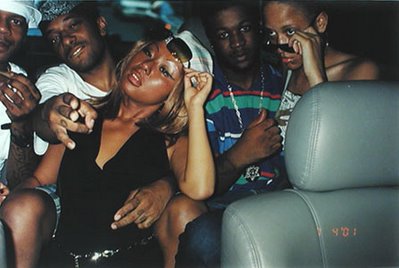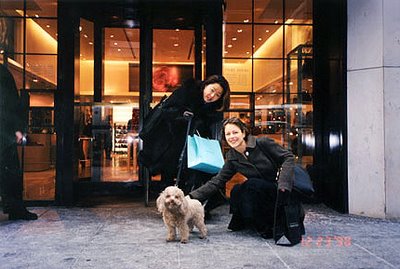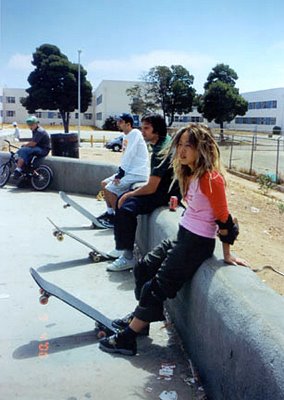
The Hispanic Project (1), 1998
After observing particular subcultures and ethnic groups, Nikki S. Lee adopts their general style and attitude through dress, gesture, and posture, and then approaches the group in her new guise. She introduces herself as an artist (though not everyone believes her or takes it seriously), and then spends several weeks participating in the group’s routine activities and social events while a friend or member of the group photographs her with an ordinary automatic “snapshot” camera. Lee maintains control of the final image, however, insofar as she chooses when to ask for a picture and edits what photographs will eventually be displayed.

The Hip Hop Project (1), 2001

The Seniors Project (15), 1999
From schoolgirl to senior citizen, punk to yuppie, rural white American to urban Hispanic, Lee’s personas traverse age, lifestyle, and culture. Part sociologist and part performance artist, Lee infiltrates these groups so convincingly that in individual photographs it is difficult to distinguish her from the crowd. However, when photographs from the projects are grouped together, it is Lee’s own Korean ethnicity, drawn like a thread through each scenario, which reveals her subtle ruse.

The Yuppie Project (4), 1998

The Ohio Project (8), 1999
Lee’s success with these projects depends heavily on the appearance of the final photographic record. Her use of the snapshot aesthetic is partly what convinces us that she belongs—along with her uncanny ability to strike the right pose. The electronic date stamp in the corner confers scientific specificity and authenticity, while at the same time marking the picture as candid and familiar, the work of an unassuming amateur. Indeed, sometimes they are exhibited as drug-store prints push-pinned to the wall. Exhibited as enlarged, framed works of art in a museum context, however, the photographs reveal the conceptual foundation of Lee’s projects. As a group or just mixed together, the projects support and define one another.

The Skaters Project (7), 2000
Lee’s projects propose questions regarding identity and social behavior. Do we choose our social groups consciously? How are we identified by other people? Is it possible for us to move between cultures? Lee believes that “essentially life itself is a performance. When we change our clothes to alter our appearance, the real act is the transformation of our way of expression—the outward expression of our psyche.”

The Schoolgirls Project (22), 2000

The Lesbian Project (14), 1997
Born Lee Seung-Hee in Korea in 1970, Nikki S. Lee chose her American name when she came to New York in 1994. (The friend she asked to compile a list of American names used those appearing in that month’s Vogue, thus Nikki S. Lee inadvertently named herself after another much-photographed and image-changing woman, model Niki Taylor.) As a child growing up in the small South Korean village of Kye-Chang, Lee was exposed to a variety of foreign cultures through the mediating vehicles of television, popular periodicals, and music. In spite of her isolation, she developed a certain empathy for other cultures, an ability to empathize with other people that is clearly integral to her projects now. Her work is also unmistakably informed by Asian notions of identity, where identity is not a static set of traits belonging to an individual, but something constantly changing and defined through relationships with other people.

The Swingers Project (53), 1999

The Tourist Project (24), 1997

The Exotic Dancers Project # 34 2000
Questions-
- How do you think Lee's work raises questions about the nature of social identity? Do you agree withher statement that "essentially life itself is a performance?"
- How do you think Lee's images retain what the author describes as "the work of an unassuming amateur?"
- How would you compare and contrast Lee's work with the work of Richard Bellingham, from Ch. 5?

7 comments:
Her Quote directly reminds me of shakesphere "all the world is a stage and the men and women are just actors" I beleve this is Incredibly true. This concept extends beyond definitions of race and genders. you are born a certain ethnicity but you chose your race. This is proven many times. For example when childen of different ethnicites are adopted, they are raised the way their adoped parents were raised, and thus adopt thie culture's values and belief system.
For example, an African American raised in a suburb, who recieves a better education, might be accused of "trying" to act white, but this is what he knows and feels accepted by his community. If he were to find himself emmersed in a failing community of people of his ethnicity, he might find adversity, where he didnt in his neighborhood.
Sex vs Gender is also hottily debated. You are born a certain sex, but can you choose your gender? if you introduce yourself as the opposite sex, and do so convencingly, people will hardly argue unless they are sure otherwise...(If they know then there is a problem, but if they are unaware, it would be impolite to question, so they accept it)Many people believe they are a man trapped in a woman's body and vice versa. Some try to change their body.
Her work ties this concept together, and she proves it in all American groups, crossing all lines, age gender ethnicity. Its not amazing that she told them she was an artist and they accepted her as she appealed to their group, through dress and speach
her work is facinating and it is often difficult to pick her out of the crowd despite her obvious korean ethnicity. I suppose through speach and dress one can convence others of anything. YAY Salesmen!
I agree with her statement ‘essentially life itself is a performance’ but my favorite part of this statement is ‘the real act is the transformation of our way of expression the outward expression of our psyche’ which I believe it is true no matter what cloths we are wearing or what race we are growing up in, we still will perform with the personality we were born with. People have different nature. You can see in some people’s eyes that the act they are performing is not in their nature. The picture with the two dancers is a good example. You can see that look in the woman' eyes on the right side that she does not belong there.
I completely agree with her statement that "essentially life itself is a performance."
I believe the nature of self identity it just that. One big performance of what you want others to view you as. It is as though you can simply change your dress or appearance and one swift change in attitude, you display or stand for something else. I have encountered way too many people through my life who display this for it not to be true. I have even been guilty of it. And I believe Lee did a wonderful job capturing this idea. When I first viewed the photos, without reading the text, I really thought she was just photographing different cultures. But, after looking more indepth, and reading as well, I could barely believe that it was her in each. She flows so smoothly into the photo, without even making me think she does not belong--even AFTER I found out that she "didn't".
I really enjoy this artist's work. If I hadn't known that she was in all the pictures, I wouldn't have noticed. She fits in really well.
Her work kind of makes me rethink what I consider identity to be. I agree with her statement that "essentially life itself is a performance" because people do choose how they behave, dress and who they hang out with. Teenagers especially seem to switch from social group to social group or identity or identity. I don't know whether we ultimately find our true identity or simply just settle with the role that we are most comfortable with and continue to play it until something causes us to choose a different role whether it be a change in age, income, etc. The fact that her images do look like amateur snapshots is what makes them so believable; she really seems to be one of the group and not just an outsider looking in.
Nanzanin says that she thinks you can tell when someone is performing in something that is not their nature. I don’t really agree with that. I think that a person belongs where they put themselves and perhaps its just other people prejudiced views that makes them think that they don’t belong. Kind of like when people call white people that hang out with African Americans and "act black" "wiggas."
Very few people just are and the idea of race as culture or age as culture is a construct of society. We all chose what social group we associate with. You can be a African American suburban soccer mom, and being gay doesn't mean your social life has to center around Oaklawn.
The pictures do come off as amature shot, because they are. Lee can only closely control them during developement and presentation.
I think Lee statement means that people can assimilate themselves into a range of social groups. I think the groups that Lee had put into "project" gives us an idea about what kind of environment different people are in these days. Such as for me, I am in the "deaf project"... I am deaf so there for I will have the socialization with other deaf people, body language which would be sign language, appearance which how all deafs would comment or appeaer to other hearings or other culture.. I think I could really relate to Lee's work. Not only taking people by their body language, appearance and socilization but by who they are and what they have to cope with everyday in life.
I love the idea behind these photographs. Not only am I extremely impressed with her ability to blend in visually with the different groups she chose to portray, but also mentally and sociologically. It truely is a display that you are who you choose to be, and that yes, you do have a choice. Her ability to take interesting and relevent pictures of her unnatural surroundings is also quite impressive.
-Zach Phillips
Post a Comment